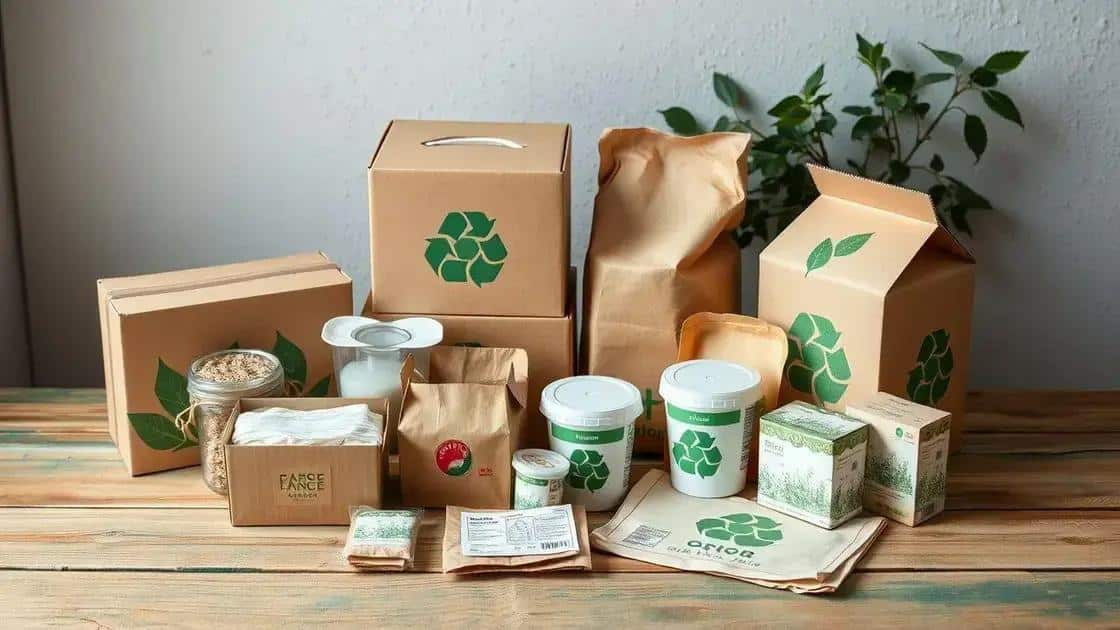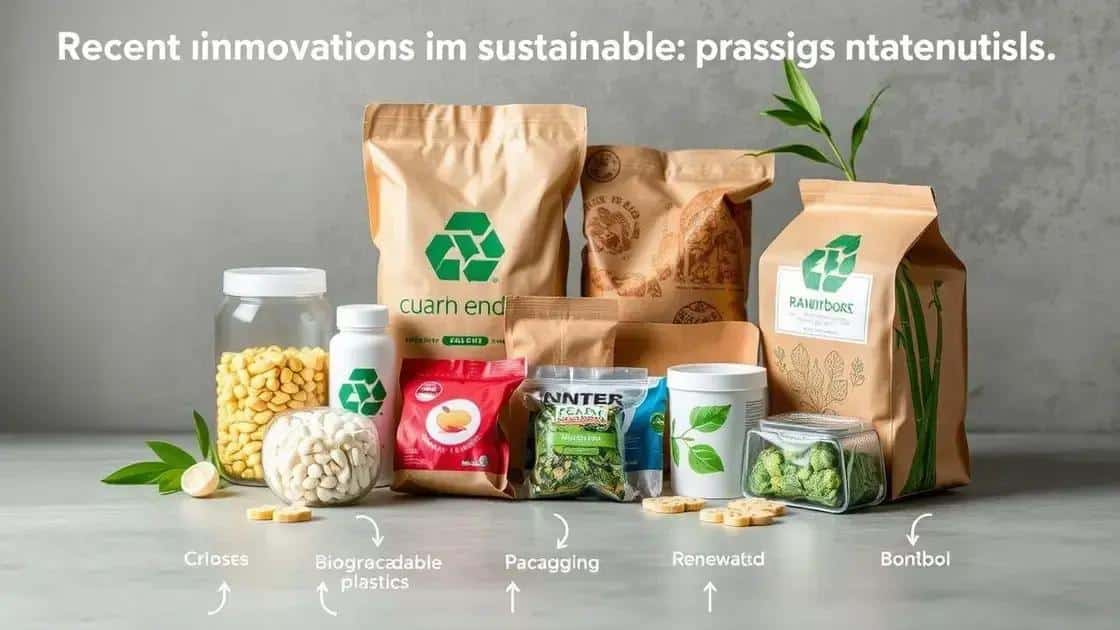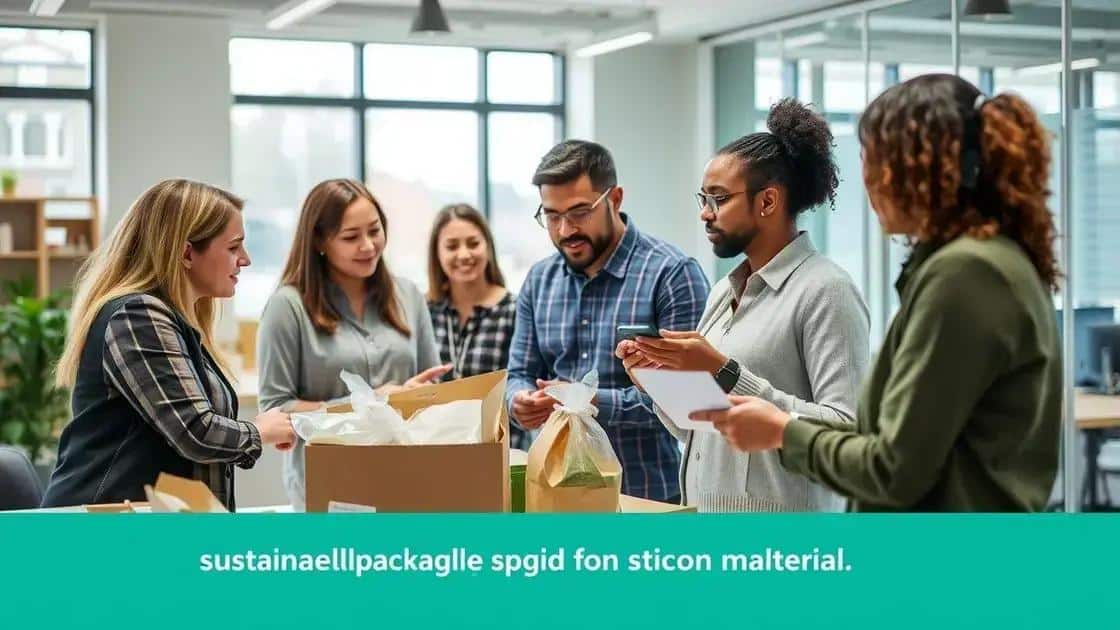Insights on sustainable packaging news: What you need to know

Sustainable packaging news highlights essential innovations and practices that businesses can adopt to minimize environmental impact while meeting consumer expectations for eco-friendly solutions.
Insights on sustainable packaging news are more crucial than ever as businesses shift towards eco-friendly practices. Have you noticed how many brands are changing their packaging? Let’s take a closer look at what’s happening in this space.
Understanding sustainable packaging concepts
Understanding sustainable packaging concepts is vital for businesses aiming to reduce their environmental impact. In a world where climate change is a pressing concern, adapting to eco-friendly practices is more than a trend; it’s a necessity.
What is sustainable packaging?
Sustainable packaging refers to solutions that are designed to have minimal environmental impact. This means using materials that are renewable, recyclable, or biodegradable. Companies strive to create a closed-loop system where products and their packaging can be recycled and reused rather than tossed in landfills.
Key benefits of sustainable packaging
- Reduces waste and resource consumption
- Minimizes greenhouse gas emissions
- Enhances brand reputation and consumer loyalty
By investing in sustainable packaging, businesses not only contribute to the planet’s health but also appeal to environmentally conscious consumers. This shift can lead to improved sales and customer satisfaction.
Moreover, innovation in materials, such as plant-based plastics and recycled content, is driving change in packaging design. These advancements allow for creative packaging solutions that are both functional and sustainable.
Types of sustainable packaging materials
To better understand this concept, here are some common types of materials:
- Recycled paper – Often used for boxes and wrappers.
- Bamboo – A fast-growing, renewable resource.
- Glass – Reusable and recyclable, often used for food and beverages.
- Bioplastics – Made from renewable biomass sources.
The idea is to create packaging solutions that do not harm the environment throughout their lifecycle, from production to disposal. By shifting toward sustainable packaging, industries can play a crucial role in protecting our planet for future generations.
Recent innovations in sustainable materials

Recent innovations in sustainable materials are transforming the packaging industry. As more companies commit to eco-friendly practices, new technologies and ideas emerge, making sustainable options more viable.
Biodegradable Plastics
One major innovation is the development of biodegradable plastics. These materials break down more easily than traditional plastics, reducing landfill waste. They can be created from natural sources like corn starch and sugarcane, making them a greener choice for packaging.
Recycled Materials
Another exciting area is the use of recycled materials in packaging. Companies are increasingly utilizing plastics that have already been used, cutting down on new production and energy costs. This approach not only conserves resources but also minimizes pollution.
- Post-consumer recycled content – Packaging made from products that consumers have used and recycled.
- Recycled cardboard – A common choice for boxes and containers, reducing tree cutting.
- Glass materials – Completely recyclable and reusable without loss of quality.
Investing in renewable resources is another trend gaining traction. Materials like bamboo and hemp are being harnessed for their rapid growth and minimal environmental impact. Companies looking to improve their sustainability efforts often explore these options, finding them beneficial.
Moreover, advancements in smart packaging technologies are on the rise. These include packaging that can monitor freshness, improve shelf life, and enhance user experience. Evaluating how a product is packaged helps reduce waste and adds value for consumers.
Industry trends shaping sustainable packaging
Industry trends are influencing sustainable packaging in significant ways. These trends are driving companies to innovate and adopt more eco-friendly practices, responding to both consumer demand and regulatory changes.
Rise of Eco-conscious Consumers
Today, many consumers prioritize sustainability when making purchasing decisions. Brands are responding by shifting toward greener alternatives in their packaging. This change is not just a trend; it reflects a broader movement where consumers expect transparency and responsibility from companies.
Government Regulations
Another key factor reshaping the industry is the implementation of stricter regulations. Governments worldwide are setting policies to reduce plastic waste. These regulations encourage businesses to utilize sustainable materials and practices, thus driving innovation.
- Plastic bans – Some regions prohibit single-use plastics entirely.
- Recycling mandates – Standards are being put in place for companies to ensure their packaging is recyclable.
- Incentives for eco-friendly practices – Financial benefits for companies that adopt sustainable methods.
Additionally, advancements in technology are opening new opportunities in sustainable packaging. Innovations such as smart packaging are enhancing how products are delivered and consumed. Smart packaging can include features that monitor freshness or improve user experience.
Sustainability is also a focus of collaboration. Many companies are partnering with NGOs and other organizations to improve their environmental practices. These collaborations enhance brand credibility while contributing to larger sustainability goals.
Guidelines for implementing sustainable practices

Implementing sustainable practices in packaging requires careful planning and execution. Companies can adopt various strategies to ensure they are making environmentally friendly choices while still meeting consumer needs.
Assessing Current Practices
The first step is to evaluate existing packaging methods. Understanding where improvements can be made is crucial. Companies should ask themselves: What materials are used? Are they recyclable? Is there excessive waste?
Setting Clear Goals
Next, it is essential to set clear sustainability goals. Define what success looks like for your organization. Whether it’s reducing plastic use by a percentage or increasing the use of recycled materials, measurable goals guide the process.
- Reduce waste in production processes
- Increase the use of renewable materials
- Enhance recycling programs for customers
Incorporating feedback loops is key. Keep track of progress and adjust strategies as necessary to meet the set goals. Engaging employees and stakeholders in this process drives accountability and innovation.
Training staff on sustainability practices is fundamental. Educating employees about the importance of using sustainable materials and reducing waste empowers them to make eco-conscious decisions. Incorporating sustainability in the company culture makes a significant impact.
Collaborating with Suppliers
A successful implementation also depends on collaboration with suppliers. Choose vendors who share the same commitment to sustainability. This partnership helps ensure that all materials used align with your sustainability goals.
Finally, promote transparency in your sustainability efforts. Share progress with consumers, and highlight eco-friendly practices on packaging. This builds trust and engages customers who value sustainability.
FAQ – Frequently Asked Questions about Sustainable Packaging Practices
What are sustainable packaging practices?
Sustainable packaging practices involve using materials and techniques that minimize environmental impact, such as recycling, biodegradability, and reducing waste.
Why is it important to collaborate with suppliers?
Collaborating with suppliers who share a commitment to sustainability ensures that all materials align with your eco-friendly goals, making the packaging process more effective.
How can my business start implementing sustainable practices?
Start by assessing your current packaging methods, setting clear sustainability goals, and training employees on eco-friendly practices.
What benefits do consumers expect from sustainable packaging?
Consumers increasingly expect transparency regarding packaging materials, and they value brands that demonstrate a commitment to environmental responsibility and sustainability.






